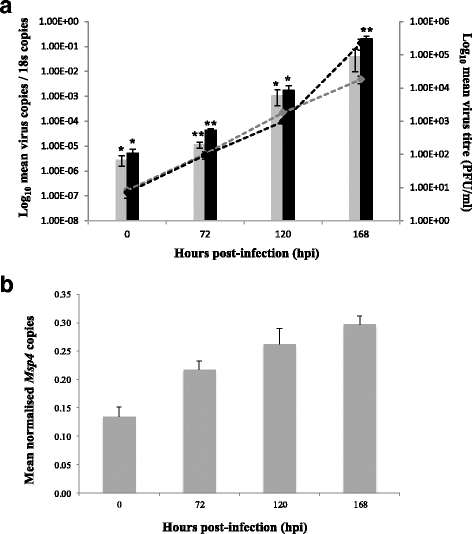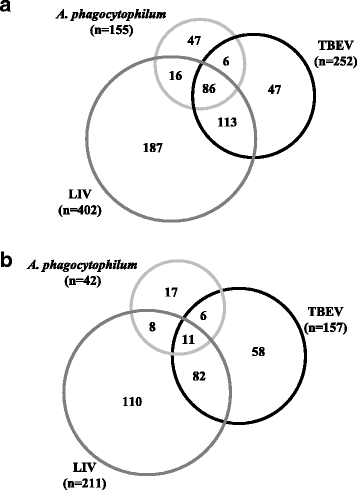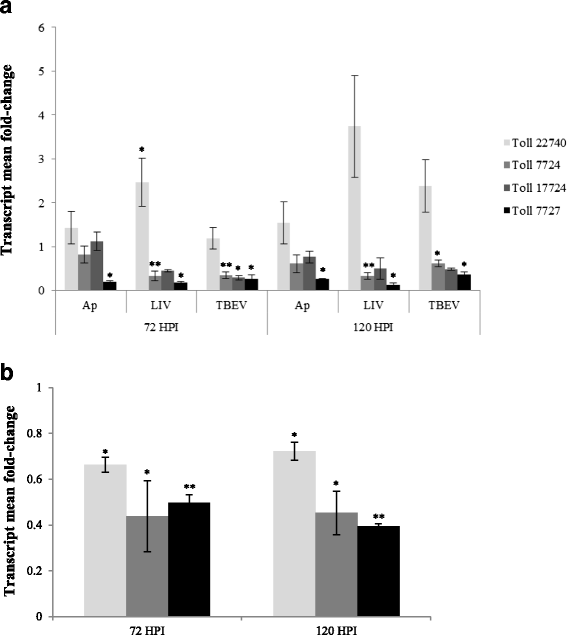Tick-borne pathogens induce differential expression of genes promoting cell survival and host resistance in Ixodes ricinus cells
- PMID: 28202075
- PMCID: PMC5312269
- DOI: 10.1186/s13071-017-2011-1
Tick-borne pathogens induce differential expression of genes promoting cell survival and host resistance in Ixodes ricinus cells
Abstract
Background: There has been an emergence and expansion of tick-borne diseases in Europe, Asia and North America in recent years, including Lyme disease, tick-borne encephalitis and human anaplasmosis. The primary vectors implicated are hard ticks of the genus Ixodes. Although much is known about the host response to these bacterial and viral pathogens, there is limited knowledge of the cellular responses to infection within the tick vector. The bacterium Anaplasma phagocytophilum is able to bypass apoptotic processes in ticks, enabling infection to proceed. However, the tick cellular responses to infection with the flaviviruses tick-borne encephalitis virus (TBEV) and louping ill virus (LIV), which cause tick-borne encephalitis and louping ill respectively, are less clear.
Results: Infection and transcriptional analysis of the Ixodes ricinus tick cell line IRE/CTVM20 with the viruses LIV and TBEV, and the bacterium A. phagocytophilum, identified activation of common and distinct cellular pathways. In particular, commonly-upregulated genes included those that modulate apoptotic pathways, putative anti-pathogen genes, and genes that influence the tick innate immune response, including selective activation of toll genes.
Conclusion: These data provide an insight into potential key genes involved in the tick cellular response to viral or bacterial infection, which may promote cell survival and host resistance.
Keywords: Anaplasma phagocytophilum; Apoptosis; Flavivirus; Immunology; Ixodes ricinus; Tick cell; Toll; Transcriptomics.
Figures




Similar articles
-
Prevalence of Anaplasma phagocytophilum in Ixodes ricinus and Dermacentor reticulatus and Coinfection with Borrelia burgdorferi and Tick-Borne Encephalitis Virus in Western Ukraine.Vector Borne Zoonotic Dis. 2019 Nov;19(11):793-801. doi: 10.1089/vbz.2019.2450. Epub 2019 Jun 18. Vector Borne Zoonotic Dis. 2019. PMID: 31211655 Free PMC article.
-
Exploration of binary protein-protein interactions between tick-borne flaviviruses and Ixodes ricinus.Parasit Vectors. 2021 Mar 6;14(1):144. doi: 10.1186/s13071-021-04651-3. Parasit Vectors. 2021. PMID: 33676573 Free PMC article.
-
Tissue-Specific Signatures in the Transcriptional Response to Anaplasma phagocytophilum Infection of Ixodes scapularis and Ixodes ricinus Tick Cell Lines.Front Cell Infect Microbiol. 2016 Feb 10;6:20. doi: 10.3389/fcimb.2016.00020. eCollection 2016. Front Cell Infect Microbiol. 2016. PMID: 26904518 Free PMC article.
-
Pathogens transmitted by Ixodes ricinus.Ticks Tick Borne Dis. 2024 Nov;15(6):102402. doi: 10.1016/j.ttbdis.2024.102402. Epub 2024 Oct 4. Ticks Tick Borne Dis. 2024. PMID: 39368217 Review.
-
Pathogen transmission in relation to duration of attachment by Ixodes scapularis ticks.Ticks Tick Borne Dis. 2018 Mar;9(3):535-542. doi: 10.1016/j.ttbdis.2018.01.002. Epub 2018 Jan 31. Ticks Tick Borne Dis. 2018. PMID: 29398603 Free PMC article. Review.
Cited by
-
Tick-Pathogen Interactions and Vector Competence: Identification of Molecular Drivers for Tick-Borne Diseases.Front Cell Infect Microbiol. 2017 Apr 7;7:114. doi: 10.3389/fcimb.2017.00114. eCollection 2017. Front Cell Infect Microbiol. 2017. PMID: 28439499 Free PMC article. Review.
-
Tick-Borne Viruses and Biological Processes at the Tick-Host-Virus Interface.Front Cell Infect Microbiol. 2017 Jul 26;7:339. doi: 10.3389/fcimb.2017.00339. eCollection 2017. Front Cell Infect Microbiol. 2017. PMID: 28798904 Free PMC article. Review.
-
Multi-omics analysis of SFTS virus infection in Rhipicephalus microplus cells reveals antiviral tick factors.Nat Commun. 2025 May 21;16(1):4732. doi: 10.1038/s41467-025-59565-w. Nat Commun. 2025. PMID: 40399277 Free PMC article.
-
A Roadmap for Tick-Borne Flavivirus Research in the "Omics" Era.Front Cell Infect Microbiol. 2017 Dec 22;7:519. doi: 10.3389/fcimb.2017.00519. eCollection 2017. Front Cell Infect Microbiol. 2017. PMID: 29312896 Free PMC article. Review.
-
Potential mechanisms implied in tick infection by arboviruses and their transmission to vertebrate hosts.Integr Zool. 2025 Mar;20(2):315-330. doi: 10.1111/1749-4877.12875. Epub 2024 Jul 17. Integr Zool. 2025. PMID: 39016029 Free PMC article. Review.
References
-
- Bacon RM, Kugeler KJ, Mead PS. Centers for Disease Control and Prevention (CDC). Surveillance for Lyme disease - United States, 1992–2006. MMWR Surveill Summ. 2008;57:1–9. - PubMed
Publication types
MeSH terms
Substances
Grants and funding
LinkOut - more resources
Full Text Sources
Other Literature Sources
Molecular Biology Databases

